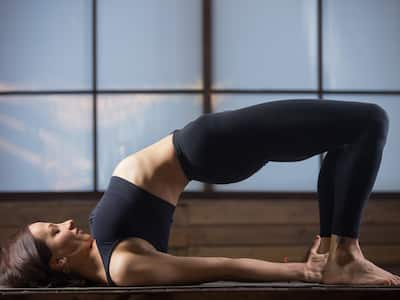Don’t Miss Out on the Latest Updates.
Subscribe to Our Newsletter Today!
Bridge Pose (Setu Bandha Sarvangasana): How To Practice, Benefits And Precautions

Whether you have digestive issues or suffering from a serious disease like thyroid, practising the bridge pose can help you in more ways than one. Here's everything you need to know about it.
Bridge pose, also known as Setu Bandha Sarvangasana, is one of the first postures that beginners are recommended to include in their regimen. In Sanskrit, setu means "bridge," sarva means "all," and anga means "limb." In other words, Setu Bandha Sarvangasana uses all of your limbs to construct a bridge with your body. Practising this pose allows you to pay attention to and care for your body and its movements. It awakens the senses, soothes the mind and rejuvenates the body. It is performed to strengthen the legs and hips, open the heart and massage the spine.
How To Perform Bridge Pose?
Here's a step-by-step guide to practising the bridge pose:
- Lie on your back on a mat, with your knees bent and feet on the floor.
- Firmly press your feet and arms into the ground. Lift your hips toward the ceiling while exhaling.
- Tuck your shoulder blades underneath you and interlace your hands while pressing down on them as you elevate your body.
- Hold your buttocks off the floor by drawing your tailbone toward your pubic bone. Squeeze your glutes while you do this.
- Straighten your arms and press your forearms into the mat as much as possible. Reach for your heels with your knuckles.
- Keep your thighs and feet parallel don't let your knees sink together or slide to the outer borders of your feet.
- Press your weight evenly across all four corners of both feet. Lengthen your tailbone toward the backs of your knees.
- Hold the position for up to one minute. Unclasp your hands and set them palms down alongside your body to release.
- Lift your hips even higher for a few breaths near the end if possible. Feel the stretch in your hip flexors and the front of your body.
- Now carefully drop your hips, vertebra by vertebra, until your tailbone reaches the floor. As you finish the pose, take a few deep breaths.
Variations and modifications:
Also Read
You can try a few variations when it comes to performing the bridge pose:
- Place a block or bolster under your lower back immediately above your tailbone if you're having problems keeping your hips elevated.
- Keep your hands alongside your body with your palms pressed into the mat rather than clasping them beneath your torso if your shoulders are really tight.
- Try using a block between your thighs to emphasise inner thigh strength.
Benefits Of Bridge Pose
Doing the bridge pose can help you in a plethora of ways, which include:
- Strengthening your back muscles
- Stretching the chest, neck and spine
- Relieving tired back
- Calming the brain by reducing anxiety and stress
- Relieving thyroid problems
- Improving digestive problems
- Relieving the symptoms of menopause and menstrual pain
- Helping people with high blood pressure, asthma and sinusitis
Precautions
While the pose is not difficult; there are a few things you should keep in mind:
- People with back problems should avoid doing the pose as it may aggravate the problem.
- Avoid doing this pose if you have any neck injuries.
- Try to perform within the range of your abilities and do not push your limits.
- Consult a physician and a yoga practitioner before doing the pose if you have a pre-existing health condition.


